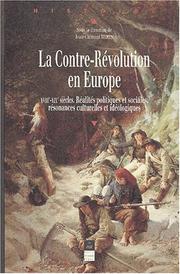| Listing 1 - 2 of 2 |
Sort by
|

ISBN: 2868475604 2753526206 9782868475602 Year: 2001 Publisher: Rennes: Presses universitaires de Rennes,
Abstract | Keywords | Export | Availability | Bookmark
 Loading...
Loading...Choose an application
- Reference Manager
- EndNote
- RefWorks (Direct export to RefWorks)
La Contre-Révolution possède une existence historiographique paradoxale. Si elle est citée comme une menace constante et une force dangereuse, elle n'est présentée que sous une forme fragmentée, assemblant pêle-mêle les nobles de l'émigration, les penseurs militants, avec les ruraux de l'Ouest ou du Midi, les Viva Maria italiens et les paysans belges, à qui sont adjoints les pays européens entrés en guerre – l'Angleterre de Pitt en tête. Omniprésente dans l'ombre mais souvent absente du discours historique, la Contre-Révolution reste mal connue. Depuis une vingtaine d'années, l'histoire scientifique reprend cette question à nouveaux frais. C'est l'objet de ces pages que de proposer, modestement, à la fois un premier bilan des travaux récents et des pistes de recherches. Sans postuler l'existence d'une quelconque unité de la Contre-Révolution, cette rencontre entre des historiens européens brosse le tableau de cette réalité politique et sociale complexe, et montre la Contre-Révolution à la fois puissante et faible, essentielle et marginale. Elle met en valeur l'hétérogénéité des chronologies qui existent dans les différents pays, ceci expliquant la diversité des formes d'intervention de la Contre- Révolution. Enfin elle insiste sur l'importance fantasmatique de la Contre-Révolution européenne. La reconnaissance de la place de la Contre- Révolution dans les jeux politiques en France et en Europe permet de comprendre les affrontements qui lui furent liés comme autant d'épisodes des guerres civiles à l'intérieur de chacun des pays européens, ainsi que des moments de la lutte « internationale » ou « idéologique » qui a traversé toute l'Europe dans les XIXe et XXe siècles.
Counterrevolutions --- Contre-révolutions --- History --- Congresses --- Histoire --- Congrès --- Europe --- Politics and government --- Social conditions --- Politique et gouvernement --- Conditions sociales --- Contre-revolutions --- Contre-révolutions --- Congrès --- Counter-revolution --- 18th-19th centuries --- Contre-revolutions - Europe - Histoire - 18e siecle - Congres --- Contre-revolutions - Europe - Histoire - 19e siecle - Congres --- contre-révolution --- historiographie --- histoire politique --- histoire sociale
Book
ISBN: 9780814683057 0814683053 9780814683309 Year: 2014 Publisher: Collegeville: Liturgical press,
Abstract | Keywords | Export | Availability | Bookmark
 Loading...
Loading...Choose an application
- Reference Manager
- EndNote
- RefWorks (Direct export to RefWorks)
Focolare, Community of Sant'Egidio, Neocatechumenal Way, Legionaries of Christ, Communion and Liberation, Opus Dei. These are but a few of the most recognizable names in the broader context of the so-called ecclesial movements. Their history goes back to the period following the First Vatican Council, crosses Vatican II, and develops throughout the twentieth century. It is a history that prepares the movements' rise in the last three decades, from John Paul II to Francis. These movements are a complex phenomenon that shapes the Church now more than before, and they play a key role for the future of Catholicism as a global community, in transition from a Europe-centered tradition to a world Church.
Catholic Action --- Catholic Church --- Societies, etc. --- History --- 27 "19" --- 27 "19" Histoire de l'Eglise--20e eeuw. Periode 1900-1999 --- 27 "19" Kerkgeschiedenis--20e eeuw. Periode 1900-1999 --- Histoire de l'Eglise--20e eeuw. Periode 1900-1999 --- Kerkgeschiedenis--20e eeuw. Periode 1900-1999 --- Action, Catholic --- Apostolate, Lay --- Lay apostolate --- Social justice --- Religious aspects --- Church of Rome --- Roman Catholic Church --- Katholische Kirche --- Katolyt︠s︡ʹka t︠s︡erkva --- Römisch-Katholische Kirche --- Römische Kirche --- Ecclesia Catholica --- Eglise catholique --- Eglise catholique-romaine --- Katolicheskai︠a︡ t︠s︡erkovʹ --- Chiesa cattolica --- Iglesia Católica --- Kościół Katolicki --- Katolicki Kościół --- Kościół Rzymskokatolicki --- Nihon Katorikku Kyōkai --- Katholikē Ekklēsia --- Gereja Katolik --- Kenesiyah ha-Ḳatolit --- Kanisa Katoliki --- כנסיה הקתולית --- כנסייה הקתולית --- 가톨릭교 --- 천주교 --- Catholic Action - Europe. --- Christianity --- foundational myths --- the Second Vatican Council --- ecclesial movements --- religious movements --- scholarly literature --- religious cults --- new religious movements --- juridical ecclesiology --- sects --- theology of the laity --- social origins of religious groups --- the 1960 --- the 1970s --- fundamentalism --- Revanche de Dieu --- movements in the Catholic Church --- Catholic movement --- Catholic action --- the reform movements of the late nineteenth and early twentieth centuries --- Leo XIII and Pius X --- Pius IX --- the Catholic Movement from the Counter-Revolution to the 'Social Question' --- origins of the organized Catholic laity --- Catholic Movement and political ideologies of the twentieth century --- Pius XI's pontificate --- Pius XI's Catholic action --- the Reconquista --- Opus Dei --- the Legionaries of Christ --- the Cursillos de Cristianidad --- war --- Focolare --- Gioventu Studentesca --- Pius XII's Militant Church --- Vatican II and ecclesial movements --- culture of presence --- Catholic dissent --- Monastic communities --- Paul VI --- Neo-Monastic communities --- Taizé and Bose --- John Paul II --- lay identities and clerical tendencies --- Benedict XVI --- Francis --- orthodoxy --- custom-made faith --- theology of the people --- new Catholic movements and priestly formation in the seminaries --- lay groups --- multi-vocational groups --- the Neocatechumenal way --- canonical and theological issues --- the Apologetics of Enmity --- the Postconciliar Church --- the Tridentine period --- Vatican II --- Catholic movements --- bishops --- clergy --- lay laity --- Loci Theologici --- new Catholic movements --- the Ecclesiastical Institution --- inclusiveness in the Church --- ecclesial movements and post-Vatican II Catholicism --- Catholic movements and the European political arena --- secularization --- confessionalization --- revanchism --- redemption
| Listing 1 - 2 of 2 |
Sort by
|

 Search
Search Feedback
Feedback About UniCat
About UniCat  Help
Help News
News